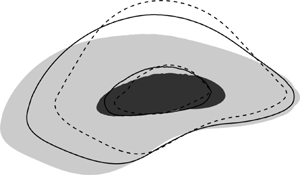Article contents
Optimal white-noise stochastic forcing for linear models of turbulent channel flow
Published online by Cambridge University Press: 24 April 2023
Abstract

In the present study an optimisation problem is formulated to determine the forcing of an eddy-viscosity-based linearised Navier–Stokes model in channel flow at  $Re_\tau \approx 5200$ (
$Re_\tau \approx 5200$ ( $Re_\tau$ is the friction Reynolds number), where the forcing is white-in-time and spatially decorrelated. The objective functional is prescribed such that the forcing drives a response to best match a set of velocity spectra from direct numerical simulation (DNS), as well as remaining sufficiently smooth. Strong quantitative agreement is obtained between the velocity spectra from the linear model with optimal forcing and from DNS, but only qualitative agreement between the Reynolds shear stress co-spectra from the model and DNS. The forcing spectra exhibit a level of self-similarity, associated with the primary peak in the velocity spectra, but they also reveal a non-negligible amount of energy spent in phenomenologically mimicking the non-self-similar part of the velocity spectra associated with energy cascade. By exploiting linearity, the effect of the individual forcing components is assessed and the contributions from the Orr mechanism and the lift-up effect are also identified. Finally, the effect of the strength of the eddy viscosity on the optimisation performance is investigated. The inclusion of the eddy viscosity diffusion operator is shown to be essential in modelling of the near-wall features, while still allowing the forcing of the self-similar primary peak. In particular, reducing the strength of the eddy viscosity results in a considerable increase in the near-wall forcing of wall-parallel components.
$Re_\tau$ is the friction Reynolds number), where the forcing is white-in-time and spatially decorrelated. The objective functional is prescribed such that the forcing drives a response to best match a set of velocity spectra from direct numerical simulation (DNS), as well as remaining sufficiently smooth. Strong quantitative agreement is obtained between the velocity spectra from the linear model with optimal forcing and from DNS, but only qualitative agreement between the Reynolds shear stress co-spectra from the model and DNS. The forcing spectra exhibit a level of self-similarity, associated with the primary peak in the velocity spectra, but they also reveal a non-negligible amount of energy spent in phenomenologically mimicking the non-self-similar part of the velocity spectra associated with energy cascade. By exploiting linearity, the effect of the individual forcing components is assessed and the contributions from the Orr mechanism and the lift-up effect are also identified. Finally, the effect of the strength of the eddy viscosity on the optimisation performance is investigated. The inclusion of the eddy viscosity diffusion operator is shown to be essential in modelling of the near-wall features, while still allowing the forcing of the self-similar primary peak. In particular, reducing the strength of the eddy viscosity results in a considerable increase in the near-wall forcing of wall-parallel components.
- Type
- JFM Papers
- Information
- Copyright
- © The Author(s), 2023. Published by Cambridge University Press
References
- 6
- Cited by





